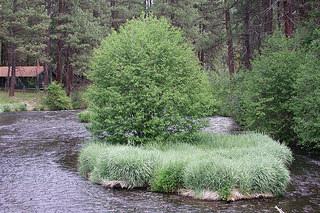An ornamental garden grass is causing problems along a wild, scenic river in Oregon
An island in the Metolius River, covered with ribbon grass. Though it may look pretty, it is damagaing the river's ecosystem by squeezing out native wildflowers and winter habitat for fish
On the banks of the Metolius River in central Oregon, large areas — even entire islands — are covered in a thin, green grass called ribbon grass. It’s a pretty, leafy plant — and it’s also an invasive species that is choking one of Oregon’s most pristine waterways.
Better Homes and Gardens calls variegated ribbon grass “a perfect plant for adding a dose of color anywhere you don't want to maintain; it's a fast-spreading variety perfect for covering slopes.” But on the banks of the Metolius River and in other areas of the Pacific Northwest, it’s causing ecological harm.
In most areas, the grass is relatively contained. On the Metolius River, it’s growing like crazy. This year the Oregon legislature listed ribbon grass as an official noxious weed.
US Forest Service ecologist Maret Pajutee says rumor has it that ribbon grass came to Oregon in the 1950s, when someone planted the pretty grass in a flowerbed. Then, like most invasive plants, it kept growing.
“I think the reason it has done so well here is the character of the Metolius and its spring-fed nature,” says Pajutee. “It really found the perfect home where it can spread.” But as it spread, it naturally began to push out native grasses and wildfowers. And as the wildflowers disappeared, the number of pollinating insects dropped.
Another big concern is that ribbon grass doesn’t provide enough cover for fish to hide in the winter, which is a problem because the Metolius is home to Oregon’s healthiest bull trout population and recovering salmon sockeye runs.
But the Friends of the Metolius group is trying to get rid of the ribbon grass. The conservation group has tried several tactics over the years. They tried throwing black tarps over the grass, but that didn’t work very well. Then they tried hand-picking it. Pete Schay, of the Friends of the Metolius, says handpicking the grass was backbreaking labor.
“It’s very heavy. It’s mostly water — it’s 99 percent water that you’re dragging around,” he says. Several years ago, crews cleared one area of the grass, filled the bed of a pickup truck with it, hauled it to a gravel pit and covered it with a tarp to kill it. A few years later, the ribbon grass started growing in the waterless gravel pit.
Now they are turning to herbicides.
“It’s been a very difficult process — because if you had to pick the most sensitive place you could possibly talk about to use herbicides, it might be the Metolius River,” Pajutee said.
Mike Crumrine, of the Oregon Department of Agriculture, is one of the main people in charge of applying herbicide. To do this, he wades into the frigid river waters and applies the herbicide with, in essence, a sponge — rubbing every bit of the plant that grows above water level. There’s only a small window every fall when the herbicide application can be effective.
Like hand-picking, this sounds like a Herculean effort, but Crumrine believes that over time this technique will reduce the ribbon grass to a point where it’s “ecologically insignificant.”
Water quality tests have shown the herbicides haven’t hurt fish or other species in the river — and the herbicides are working. There are finally a few places where native plants have started to come back.
This story is based on a report by Courtney Flatt that aired on PRI's Living on Earth in collaboration with the public media collaborative Earthfix
